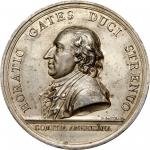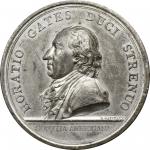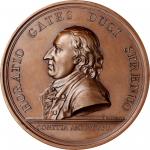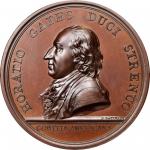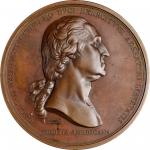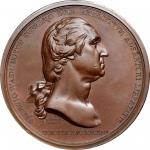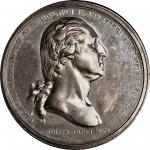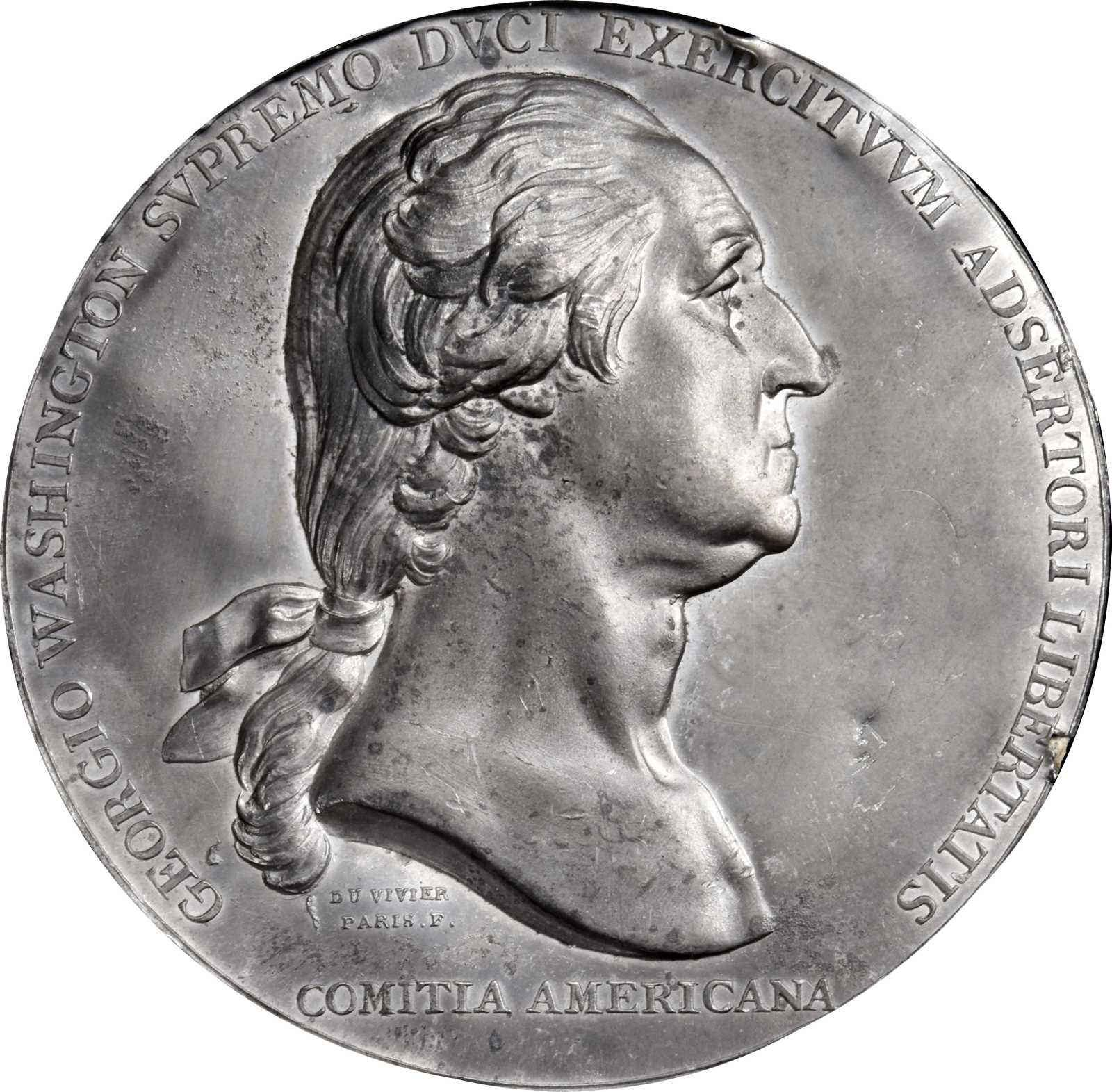1776 Washington Before Boston obverse cliche. As Betts-542, Musante GW-09, as Baker-47, Mooney M3. White metal. Original striking. Workshop of Duvivier. 63.1 mm, 453.4 grains. 0.3 - 0.7 mm thick. About Uncirculated.Plain trimmed edge. Backed with remnants of paper fiber. An impression on a thin puddled sheet of tin, fully realizing Duviviers magnificent rendition of the Houdon portrait in bold relief. The surfaces glow with luster and elegant toning highlights of bright blue and ancient gold over deep pewter gray. The rims have been trimmed down to nearly the tops of the legends. A raised wire rim surrounds the top, near 12:00. A natural flaw is seen above ER of LIBERTATIS, as made. A light dent is present low in the right obverse field, and a contact point on the rim has folded the edge above ER of EXERCTVVM. A glass finds some trivial tinpest hidden in the hair, as well as a tiny patch at the tip of the nose. The visual appeal is superb, and though this appears at first blush to be fragile, it is stout and solid, raising the full depth of the portrait from the fields.<p>While we can count at least three cliches of the rejected obverse die - best distinguished from this one by an exergue line at the bust truncation - this die may be unique in this form. All three of the rejected obverse cliches are now impounded. The one from Dupres personal collection has been in the Boston Public Library since 1888. The Norweb specimen, plated by Fuld in the TAMS Journal in 1963, was donated to the American Numismatic Society and is plated in Alan Stahls catalog of their Comitia Americana medals (<em>Coinage of the American Confederation Period, 1995</em>). The Garrett specimen, one of a matched pair, was acquired by Stanley Scott and donated to Mount Vernon in 1985.<p>If this is indeed the only cliche known from this obverse die (and we have heard of no others in any collection, public or private), it represents the single earliest impression from these dies extant, the piece that comes closest to Duviviers die that struck Washingtons own gold medal shortly thereafter. Indeed, this was likely produced by Duvivier himself before the dies made their way to the Paris Mint, preserved by chance, an accidental interloper from an artists workbench in 1789 that has survived until the present day. It is, accordingly, of the very highest historical importance.<strong>A Note On Trials: Clichés, Épreuves, and Splashers </strong><p><p>The Adams Collection of Comitia Americana and related medals is uniquely enriched by several specimens of a unique form of medallic production that is known by several different names. Typically struck from a die in its earliest state, usually before hardening, these trials were called épreuves - proofs - in the original French correspondence between Dupre and Duvivier and the Founding Fathers charged with the acquisition of the medals the Continental Congress authorized. In more modern numismatic literature, they are more often called clichés or splashers, the latter term being a fair description of just how these trials were made.<p>Unhardened dies are incredibly susceptible to damage, as 18th century die steel (and modern steel today) is brittle before it is hardened by quenching. Once a die is hardened, modification becomes very difficult, so if changes need to be made, they need to be done in that fragile, unhardened state. Engravers in major mints - Paris especially - were accustomed to making soft metal impressions as something of a proofreading copy, enabling the negative die to be viewed in the positive in rough draft form. Wax impressions were liable to leave bits of wax in the interstices of design elements, thus engravers settled upon tin (usually called "white metal" in modern numismatic circles) as the best medium.<p><p>Tin melts at 450 degrees Fahrenheit, a low enough melting point to be accomplished in any small workshop. A ladle full of molten tin poured onto a surface will cool and harden fairly quickly, but remain soft long enough that a die can be easily pushed into it by hand, leaving a relatively durable impression in medal. Most often, medalists would find a piece of scrap paper - a note, a newspaper, a book page - to pour the tin atop, thus preventing their workspace from getting scorched and making the tin sheet somewhat easier to lift and trim. <p><p>These splashers were not intended to be medals, or even permanent, but simply a temporary way to display the state of the die in the positive before its devices were rendered immovable. Each was personally crafted by the engraver in his shop. In the case of the Comitia Americana medals, the épreuves made by Duvivier, Dupre, and Gatteaux were ultimately intended to be viewed and handled by themselves and those close to the process. Benjamin Franklin reviewed the épreuves of the De Fleury medal between April 20 and May 4, 1780, then made recommendations regarding the lettering in the obverse exergue that were adopted by Duvivier. He later did the same with his Libertas Americana medal, correcting a spelling error on the reverse. Engraver Augustin Dupre retained many of his splashers in his personal collection, some of which found their way into institutions in France and the United States, some of which are in the present sale.<p><p>Thomas Jefferson used clichés as a spendthrift (and lightweight) way to collect all the medals of the Comitia Americana series, assembling a set for himself and another for his Virginia countryman James Madison. As he was preparing to depart Paris in September 1789, he wrote to Madison to let him know of the boxes he was shipping, including a box of books and several crates full of Houdons John Paul Jones busts that the sitter wanted to have distributed in America. <p><p><em>I have put a collection of the proofs in tin of the medals voted by the U. S. (except two, of which the dies are in America) the medals themselves not being allowed to be taken, I desired the workmen to let me have two sets of their last proofs; for their manner is, as their work proceeds, to make impressions of it in pure tin, in order to correct &c. These proofs are in fact more delicate than the medals themselves, and the last of them shew the impressions complete. I have had them arranged in a frame, under glass &c. & beg your acceptance of them.</em><p><p>By "delicate," Jefferson did not mean fragile, but well-detailed. The modern whereabouts of these sets are unknown; it is very possible that some proportion of either of these sets are in the current sale.<p><p>Jeffersons set left Monticello in February 1798 in the hands of an enslaved man named York, who Jeffersons son-in-law and overseer, the abusive drunkard Thomas Mann Randolph, called "allmost (sic) an idiot." Randolph told Jefferson that the thief had confessed, listing off an inventory of items from Jeffersons chambers including "some impressions in lead & tin of Dies of the Medals & Coins." He continued "I have some hope of recovering the proofs of Medals (tis from the description I conclude they are out) I have traced one to a Negroe of the neighbourhood who bt. it of York but he says he has lost it." The historical record on the theft and recovery thereafter falls silent; Jefferson wrote several consecutive letters to Randolph after the receipt of this letter but never acknowledged the incident. Two different men named York were enslaved by Jefferson concurrently, one of whom was inherited from the estate of Jeffersons father-in-law in 1774 and described as a "Waterman," the other of whom was born in 1781 and labored at Monticello. Presumably the York involved here was the latter of these two, aged 17 at the time of his act of resistance against Jeffersons authority.<p><p>Today, clichés of each of the Comitia Americana medals are extremely rare, with populations in the low single digits. There is not a single issue in this format that is known to the extent of 8 or 10 pieces. Matched sets of obverse and reverse are the exception rather than the rule. Each of the survivors is an accident, a piece that was made to serve a purpose at a moment in time, not produced for long-term preservation in a cabinet. Their historicity is exceptional, as each survivor was not only in the hands of the medals engraver, but likely in the hands of Thomas Jefferson, Benjamin Franklin, David Humphreys, or a small number of others. Their rarity surpasses that of their normally struck cognates in nearly every circumstance.<p><p>With the possible exception of the Charles Senter Collection, sold at auction in 1933, no cabinet has ever included such a wide array of these historic rarities as the John Adams Collection.<p><p><p><strong>The Taking of Dorchester Heights</strong><p><p><strong>The Action:</strong><p>The story of the American Revolution begins in Boston. Once the first garrisons of British regulars were established in Boston in 1768 - a response to Boston patriots notorious opposition to the Sugar Act and Stamp Act - progress toward outright rebellion was quick. The Boston Massacre of March 1770 and the Boston Tea Party of December 1773 were preludes to armed conflict, which began in April 1775 with the battles of Lexington and Concord. <p>General Thomas Gage, the Commander in Chief of British forces in North America, arrived in Boston in May 1774, not quite a year before shots were fired on Lexington Green. He was appointed Royal Governor of the colony, giving the people of Massachusetts a military government. In February 1775, King George III officially declared the colony in open rebellion, giving Gage permission to crack down on the upheaval. On April 19, when Gage moved on Lexington and Concord, the American Revolution turned from a political conflict into a war. On June 12, just days before the bloody Battle of Bunker Hill, Gage declared martial law. Boston had become an occupied city.<p>When George Washington left Mount Vernon on May 4, 1775, bound for Philadelphia as a member of the second Continental Congress, he undoubtedly presumed the next leg of his Virginia to Pennsylvania trip would return him to his Potomac River plantation. Instead, when the political temperature rose in Boston and the Continental Congress took charge of the troops that had gathered in Boston, the men gathered at Philadelphias State House quickly turned to Washington as a potential commander. Passing over John Hancock, Richard Henry Lee, and others, Washington was named General and Commander in Chief of the Continental forces by Congress on June 15. His next stop would not be home. It would be Boston.<p>He left Philadelphia a little known Virginian on June 23 and arrived in Boston on July 2 as a celebrity. He took command across the river from Boston in Cambridge, Massachusetts and got to work building an army that would expel the British and win the war. That force would require men, materiel, and weapons: guns, to be sure, but also heavy artillery.<p>Fort Ticonderoga, on the west bank of Lake Champlain, was taken by American forces under Ethan Allen and Benedict Arnold in May 1775. Once Washington began assembling his plans to push the British out of Boston, it became evident that the 59 British cannons captured at Ticonderoga represented the nearest American-held artillery - and those cannons were 300 miles away. <p>Fortunately, Washingtons army included an amateur engineer (and professional bookseller) from Boston named Henry Knox, who had familiarized himself with fortifications and cannon during the early days of the campaign. Knox, just 25 years old, impressed Washington enough that the General gave Knox command of an expedition to deliver the guns of Ticonderoga to Boston. Knox left on November 17, 1775, and arrived at Fort Ticonderoga on December 5. The winter weather was brutal on Washingtons troops, but welcome beneath the oxen hooves and the sleighs that Knox used to carry 60 tons of iron eastward. Knox took the guns south to Albany, then east to Boston, arriving in Cambridge on January 27, 1776.<p>The cannon were not originally intended for Dorchester Heights, a high ground that looked down on Boston from the south, but thats where they ended up - and they ended up there all in one night. Under cover of darkness, with the view somewhat blocked by hay bales and other temporary fortifications, Washingtons men humped the big guns to the top of the Heights. On the morning of March 5, the British forces awoke to an unimaginable sight: the high ground fortified, the guns of Ticonderoga looming, and their own position under grave threat. Washington had overseen the seemingly impossible, and made the dug-in occupation of the British in Boston indefensible. The British commander on the scene, General William Howe, is supposed to have said "My God, these fellows have done more work in one night than I could make my army do in three months."<p>When the British artillery erupted on the night of March 9, it was clear to all present that the noisy cannonade was a cover for evacuation. It took ten days for the entire occupation force to leave. After they left, it took Congress less than a week to vote to award their very first ever medal to the man who oversaw the bloodless triumph that saved Boston.<p>By rights, this medal could just as easily depict the stout Henry Knox, whose image is measurably less easy on the eyes than Antoine Houdons elegant bust of the godlike Washington. While Washington conceived the plan for the siege of Boston, only Knoxs dashing-through-the-snow derring-do enabled the Commander-in-Chief to push Howes army out to sea. <p><p><strong>The Resolution:</strong><p><em>Resolved, That the thanks of this Congress, in their own name, and in the name of the thirteen United Colonies, whom they represent, be presented to his excellency General Washington, and the officers and soldiers under his command, for their wise and spirited conduct in the siege and acquisition of Boston; and that a medal of gold be struck in commemoration of this great event, and presented to his Excellency; and that a committee of three be appointed to prepare a letter of thanks, and a proper device for the medal.</em><p><em>- Continental Congress Resolution of March 25, 1776</em><p><p><strong>The Acquisition:</strong><p>After Congress voted their hero a gold medal, the author of the proposal, Bostons John Adams, led the committee to prepare it. He also had the honor of telling General Washington of his new recognition, in a letter dated April 1.<p><em>I congratulate you, Sir, as well as all the Friends of Mankind, in the reduction of Boston, an event, which appeared to me of so great and decisive importance that next morning after the arrival of the news I did myself the honor to move for the thanks of Congress to your Excellency and that a medal of gold should be struck in commemoration of it. Congress have been pleased to appoint me, with two other gentlemen, to prepare a device. I should be very happy to have your Excellencys sentiments concerning a proper one. I have the honor to be, with very great respect,</em><p><em>sir, your most obedient and affectionate servant, John Adams.</em><p>The President of the Continental Congress, John Hancock, chimed in on April 2 in another missive to the General: "The Congress have ordered a Golden Medal, adapted to the Occasion, to be struck, and when finished, to be presented to you."<p>Hancocks "when finished" ultimately took over a decade, but Adams wasted no time in reaching out to Philadelphias best-respected numismatist, Pierre Eugène du Simitière, for help with the design. He had already heard back from the artistic Swiss antiquarian when he wrote home to his wife, Abigail, from Philadelphia on August 14, 1776:<p><em>I am put upon a Committee to prepare a Device for a Golden Medal to commemorate the Surrender of Boston to the American Arms, and upon another to prepare Devices for a Great Seal for the confederated States. There is a Gentleman here of French Extraction, whose Name is Du simitiere, a Painter by Profession whose Designs are very ingenious, and his Drawings well executed. He has been applied to for his Advice. I waited on him yesterday, and saw his Sketches. For the Medal he proposes Liberty with her Spear and Pileus, leaning on General Washington. The British Fleet in Boston Harbour, with all their Sterns towards the Town, the American Troops, marching in.</em><p><em></em>Du Simitière produced a nice design and was paid for it by the Continental Congress. It was never produced. As Congress moved on to prosecuting a full-fledged war against the most powerful nation on the planet, Washingtons medal was back-burnered by every committee assigned to it. Eventually, Benjamin Franklin, serving as the minister plenipotentiary to France, was asked to help in September 1779. Franklin dropped the ball, succeeding in obtaining only De Fleurys medal for Stony Point and his pet medallic project, the Libertas Americana medal. Time passed, and David Humphreys was asked to pick the medal project back up in the summer of 1784. He arrived in Paris soon thereafter, set to work, and by the spring of 1785 had successfully nailed down designs and inscriptions from the Academie des Inscriptions et Belles-Lettres in Paris. Washingtons medal, along with those for Horatio Gates and Nathanael Greene, was finally coming along.<p>Humphreys wrote to Washington with an update on May 10, 1785, describing the designs and inscriptions the medal would feature. "I think it has the character of simplicity & dignity which is to be aimed at in a memorial of this kind, which is designed to transmit the remembrance of a great event to posterity," Humphreys wrote, adding "you really do not know how much your name is venerated on this side the Atlantic." The next letter Humphreys sent to Washington from Paris, dated July 17, 1785, noted that "M. Houdon" was set "to depart for Mt Vernon" from Paris, with the help of Thomas Jefferson. Jean-Antoine Houdon and three assistant sculptors arrived at Mount Vernon on October 2, 1785 to produce a statue of Washington that had been commissioned by the state of Virginia. Houdon took a life mask during his two week stay, then returned to Paris to complete the project. Humphreys updated Jefferson on Washingtons medal on January 30, 1786, noting "there is no obstacle to commencing the medal for Gen. Washington, since Houdons return, etc."<p>While Humphreys apparently inquired with Augustin Dupre about accomplishing the Washington medal, the duty of executing the Houdon bust and other design elements fell to Benjamin Duvivier, who finally finished the dies in the spring of 1789. He was paid 3,600 livre tournois, more than twice the sum he received for the Cowpens medals for Howard and William Washington, and more than the 2,400 livre tournois Dupre was paid for each of the medals to be given to Daniel Morgan and John Paul Jones. The completed gold Washington medal was displayed at the Salon of 1789 that summer in Paris, then hand carried to the United States by Thomas Jefferson in October 1789.<p><strong>The Presentation:</strong><p>Unlike other Comitia Americana medals, the exact circumstances of Washingtons presentation of the medal are unknown. John Adams and Anne Bentley presume Jefferson delivered it to Washington when they met in New York on March 21, 1790. The medal disappears from the historical record until June 12, 1798, when a Polish soldier named Julian Ursyn Niemcewicz visited Mount Vernon and recorded his experience of being shown the gold medal by Martha Washington. In his diary, he noted: "Mrs. Washington showed me a small collection of medals struck during the Revolution. There is one of at least 100 ducats in gold, with the head closely resembling that of Gl. Washington, which was struck on the occasion of the evacuation of Boston." Niemcewicz also journaled about Washingtons other medals, including his silver set of Comitia Americana medals and the diamond Eagle of the Society of the Cincinnati. The only other time Washingtons gold medal was documented at Mount Vernon was in 1800, on Washingtons estate inventory, where it was listed as "1 large gold medal of George Washington" and valued at $150.<p><strong>The Washington Before Boston Medal:</strong><p><strong>Obverse:</strong> A profile of Washington, after Houdons masterful bust, with hair tied with a ribbon and the bust neatly truncated. Duviviers signature DuVIVIER / PARIS F. appears on two lines beneath the bust truncation, while COMITIA AMERICANA appears on a straight line in the unbordered exergue. The peripheral inscription GEORGIO WASHINGTON SVPREMO DVCI EXERCITVVM ADSERTORI LIBERTATIS translates to "George Washington, supreme commander of the armies, defender of liberty."<p><strong>Reverse:</strong> Washington, on horseback at left, stands with four mounted officers overlooking Boston and its harbor from Dorchester Heights. Ships at full sail depart at right on the horizon, while troops, cannons on their carriages, stacked cannonballs, and two unmounted cannon are at Washingtons right. Washington gestures to the scene below. The legend HOSTIBUS PRIMO FUGATIS means "the first flight of the enemy," while the exergual legend BOSTONIUM RECUPERATUM XVII MARTII MDCCLXXVI means "Boston recovered, March 17, 1776."<p><p><p><p><p>From the John W. Adams Collection. Acquired from our ANA sale of August 2012, lot 4115.




